
Indicator scoreboard
EMU - October M3 money supply growth rate slowed slightly to 5.3 percent when compared with last year. But the three month (August to October) moving average of annual change rose to 5.5 percent. The European Central Bank's target for M3 growth is 4.5 percent. Private sector credit growth remained high during the month.
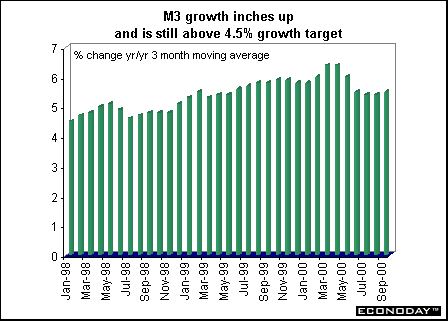
September merchandise trade surplus with the rest of the world was E3.3 billion, up from a surplus of E1.3 billion a year earlier. Exports jumped 21 percent while imports climbed 19 percent when compared with last year.
November seasonally adjusted Reuters purchasing managers' index dropped for the seventh month in a row to 54.6 - its lowest level since August 1999 - indicating that manufacturing sector growth continues to slow. The index has been declining since it reached 60.7 in April. The November index level is the lowest since August 1999 (54.4). An index level above 50 indicates the manufacturing sector is expanding, while a level below 50 indicates contraction. The higher the index above 50, the stronger sector growth. The prices index, which is not part of the overall PMI, fell to 66.7 in November from 71.9 in October. The PMI manufacturing activity index is based on data from six EMU countries (Germany, France, Italy, Spain, Ireland and Austria).
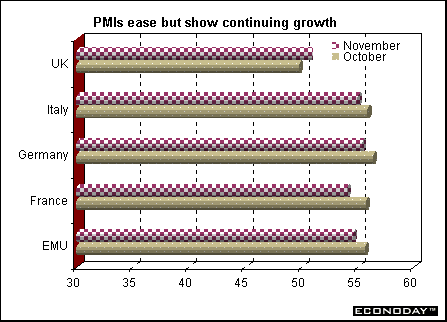
Germany - Third quarter gross domestic product rose 0.6 percent and 2.8 percent when compared with last year. On a seasonally adjusted basis, GDP climbed 0.6 percent and 3.1 percent when compared with last year. Third quarter growth stemmed from a strong rebound in equipment investment; but consumer spending was weak and net exports contributed little to growth. The data clearly show slowing growth in the third quarter.
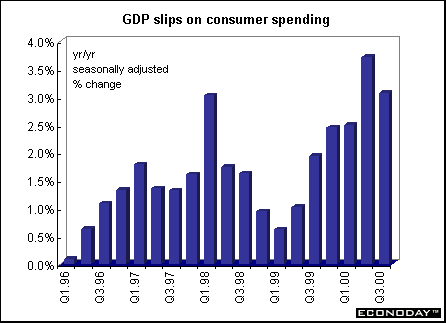
France - October seasonally adjusted unemployment rate slipped to 9.4 percent according to the International Labor Organization definition, which excludes job seekers who did any work during the month. Compared to October 1999, when the ILO rate stood at 11.0 percent, unemployment was down 423,000 or 14.7 percent. All categories of job seekers posted declines.
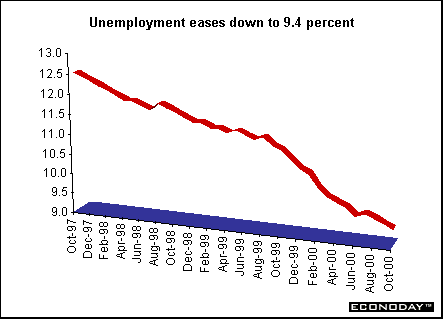
October producer price index rose 0.4 percent and jumped 6.5 percent when compared with last year. Energy prices rose 1.6 percent after a 6.3 percent surge in September. Energy prices were up 28.4 percent on the year. Excluding energy and food, the PPI rose 0.2 percent for the fourth month in a row and 2.5 percent when compared with last year.
Italy - September unadjusted retail sales rose 2.9 percent when compared with last year. The data are measured in nominal value terms and not adjusted for price changes. The increase was due primarily to a 6.5 percent jump in food sales while non-food sales posted a 0.9 percent increase. Food sales account for around 20 percent of the total index.
October producer prices rose 0.5 percent and 6.7 percent when compared to last year because of higher energy import prices, particularly for natural gas. Excluding energy and water the PPI edged up 0.1 percent and 2.8 percent when compared with last year.
September unadjusted industrial orders rose 6.2 percent when compared with last year. The overall gain was evenly balanced between domestic orders, which climbed 6.4 percent, and foreign orders, which were up 5.9 percent. Recently introduced seasonally adjusted orders data, which is still not closely followed by most analysts, showed September's orders fell 3.2 percent from August. Domestic orders dropped 2.4 percent on the month, while orders from abroad fell 4.5 percent.
Spain - October producer prices rose by 0.5 percent and were up 5.9 percent when compared to last year. The increase was mainly due to rising energy prices, which were up 2.3 percent on the month and 25.7 percent on the year. Producer prices for intermediate goods - the category in which energy prices are listed and which accounts for almost half (about 47 percent) of the weighting in the overall producer price index - rose 0.8 percent on the month and by 11.5 percent on the year.
Britain - October net consumer credit rose by Stg1.500 billion compared with a rise of Stg1.059 billion in September. In percentage terms, consumer credit rose 1.2 percent and was 13.1 percent above the level a year ago. September saw a monthly gain of 0.9 percent and a 12.8 percent annual increase.
November seasonally adjusted Nationwide house prices index rose 0.9 percent, the same as in the previous month. However, the annual rate fell to 9.1 percent from 9.9 percent in October. Nationwide also said that the recent floods are unlikely to have any significant long term impact on the housing market.
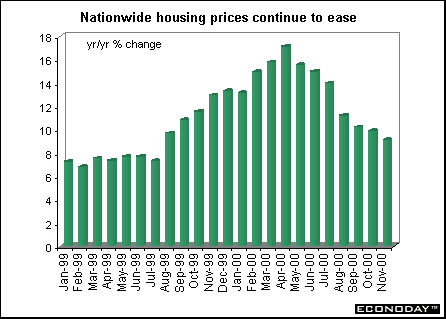
November Chartered Institute of Purchasing and Supply (CIPS) purchasing managers' index rebounded to 51.3 from 49.8 in October. The survey showed that growth in output and order books picked up in November.
Asia
Japan - October retail sales fell 2.4 percent on the year while large stores retail sales fell 2.7 percent and were down 4.5 percent when adjusted for store closings and new stores. Total sales were up 0.9 percent on the year while wholesale sales rose 2.0 percent.
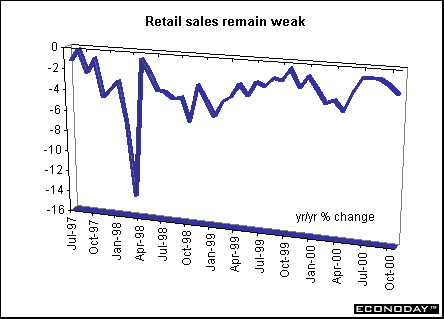
October industrial production rose 1.5 percent and 6.6 percent when compared with last year. Shipments were up 5.7 percent on the year and 0.8 percent on the month. Inventories were up 1.8 percent on the year and 1.3 percent on the month while the inventory ratio was up 0.7 percent on the year and 2.0 percent on the month.
October total construction orders received by Japan's 50 largest contractors rose 5.3 percent when compared with a year earlier. Total private sector construction orders were down 4.7 percent while total public orders rose 27.5 percent.
November Tokyo consumer price index fell 0.4 percent and was down 1.1 percent when compared with last year. October all Japan consumer price index rose 0.1 percent but was down 0.9 percent on the year. The all Japan index lags the Tokyo numbers by a month.
October unemployment rate held steady at 4.7 percent, matching a six month high. Only enough jobs to offset a rise in the number of people who started to look for work were added. The economy added 360,000 jobs in October, and 340,000 people rejoined the workforce.
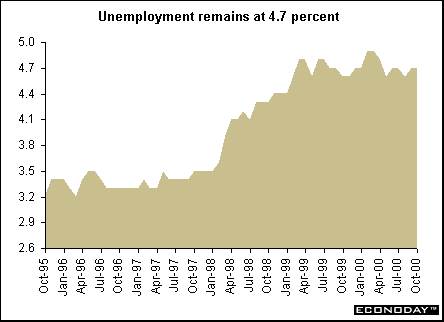
Australia - October seasonally adjusted retail sales dropped 0.2 percent. Distortions from the impact of the Olympic Games means that too much shouldn't be read into the figures.
Americas
Canada - October industrial product price index rose 0.6 percent and 4.4 percent when compared with last year. Energy prices and a higher U.S. dollar also helped boost industrial prices. Excluding energy prices the IPPI was up 2.4 percent when compared with last year. The U.S. dollar strengthened noticeably against the Canadian dollar and this had the effect of pushing up prices of commodities quoted in U.S. dollars. If the exchange rate had remained unchanged the IPPI would have remained unchanged between September and October. This effect is evident in the 12-month change also - the IPPI would have increased by 3.8 percent rather than 4.4 percent when compared with last year.
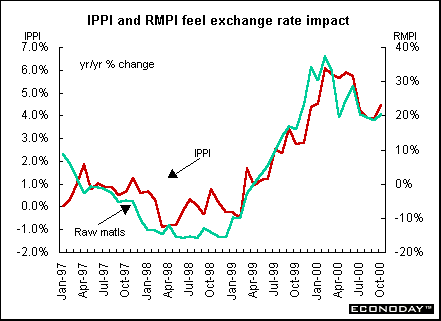
October raw material price index (RMPI) rose 0.5 percent and 20.4 percent when compared with last year. Higher prices for mineral fuels, animal and vegetable products were partly offset by lower non-ferrous metal prices. Mineral fuel prices were at the heart of both monthly and annual increases in the RMPI. If mineral fuels were excluded, the index would have advanced only 4.1 percent instead of 20.4 percent on an annual basis. The rise in the monthly index would have been 0.2 percent.
Third quarter real gross domestic product increased 1.2 percent, maintaining the pace seen over the previous six quarters. Growth originated from domestic demand, while exports stalled, edging down after more than three years of sustained growth. Consumer spending rose 1.3 percent, as purchases of motor vehicles climbed 5.1 percent, in large part because of dealer incentives. Business investment in plant and equipment remained strong; machinery and equipment purchases grew a healthy 3.8 percent. Non-residential construction investment was virtually unchanged from the second quarter. Manufacturers piled up inventories in the quarter, particularly of durable goods. The buildup occurred at all stages of production. Retailers and wholesalers also accumulated stocks, in tandem with rising sales. Exports of goods and services edged down 0.1 percent as automotive exports decreased. Exports of energy products, measured by volume, declined for a second consecutive quarter. Growth in corporation profits softened to 1.0 percent, continuing the deceleration seen in the second quarter.
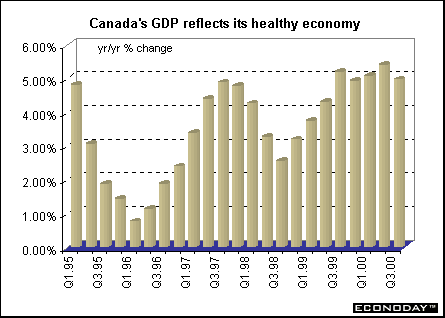
September gross domestic product at factor cost remained unchanged because of weakness in manufacturing, where production of electronic goods was scaled back for the first time in nine months and automotive goods production fell. Weakness among goods producers was widespread. Services advanced 0.2 percent, led by continued strong growth in business services, as well as by gains in food services and government services. However, wholesaling activity contracted for a second consecutive month, while retailing advanced only modestly. Total manufacturing output fell back 0.7 percent in September, as producers of electrical and electronic products and automotive goods scaled back production. Makers of food, furniture, wood and primary metal products also curtailed production. Output fell in 16 of 22 major industry groups, which accounted for 77 percent of total manufacturing activity.
November unemployment rate remained unchanged at 6.9 percent. Employment increased by an estimated 58,000. Increases in labor participation (58,000) offset the employment increase. Overall full time employment increased by 79,000. All of the employment increase was among private sector employees. Employment declined slightly among public sector employees and among the self employed. November's employment growth occurred both in the goods and service producing sectors.
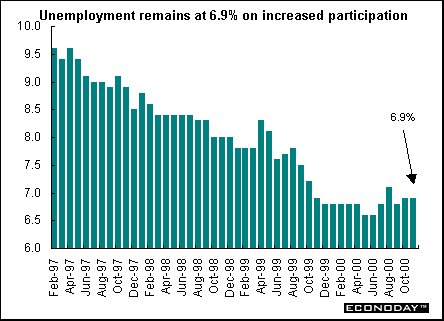


Introduction • Global Stock Market Indexes • Recap of Global Markets • Currencies • Indicator Scoreboard

The Bottom Line • Looking Ahead
© Econoday, 2000. All Rights Reserved.
|